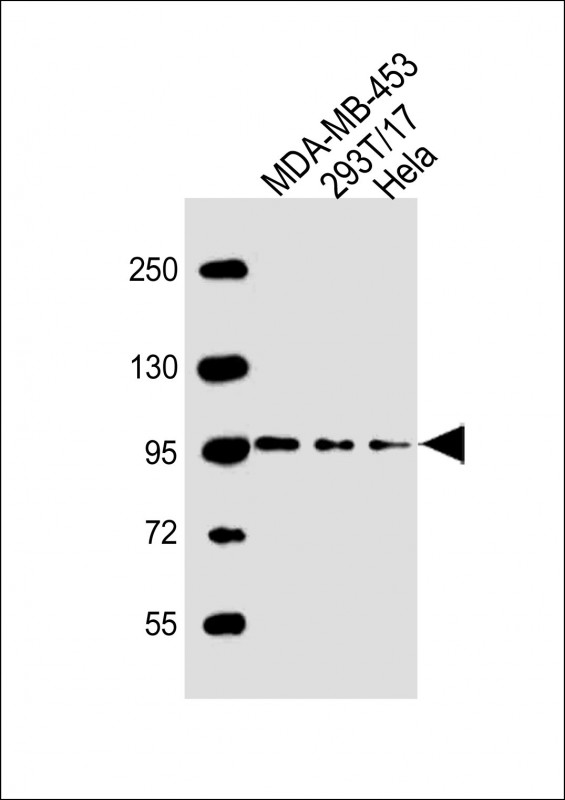FBXO11 Antibody (N-term)
Affinity Purified Rabbit Polyclonal Antibody (Pab)
- 产品详情
- 实验流程
- 背景知识
Application
| WB |
|---|---|
| Primary Accession | Q86XK2 |
| Reactivity | Human |
| Host | Rabbit |
| Clonality | Polyclonal |
| Calculated MW | 103585 Da |
| Isotype | Rabbit IgG |
| Antigen Source | HUMAN |
| Gene ID | 80204 |
|---|---|
| Antigen Region | 55-83 aa |
| Other Names | F-box only protein 11, Protein arginine N-methyltransferase 9, Vitiligo-associated protein 1, VIT-1, FBXO11, FBX11, PRMT9, VIT1 |
| Dilution | WB~~1:1000 |
| Target/Specificity | This FBXO11 antibody is generated from rabbits immunized with a KLH conjugated synthetic peptide between 55-83 amino acids from the N-terminal region of human FBXO11. |
| Format | Purified polyclonal antibody supplied in PBS with 0.09% (W/V) sodium azide. This antibody is purified through a protein A column, followed by peptide affinity purification. |
| Storage | Maintain refrigerated at 2-8°C for up to 2 weeks. For long term storage store at -20°C in small aliquots to prevent freeze-thaw cycles. |
| Precautions | FBXO11 Antibody (N-term) is for research use only and not for use in diagnostic or therapeutic procedures. |
| Name | FBXO11 {ECO:0000303|PubMed:25827072, ECO:0000312|HGNC:HGNC:13590} |
|---|---|
| Function | Substrate recognition component of a SCF (SKP1-CUL1-F-box protein) E3 ubiquitin-protein ligase complex which mediates the ubiquitination and subsequent proteasomal degradation of target proteins, such as DTL/CDT2, BCL6, SNAI1 and PRDM1/BLIMP1 (PubMed:17098746, PubMed:22113614, PubMed:23478441, PubMed:23478445, PubMed:23892434, PubMed:24613396, PubMed:24968003, PubMed:25827072, PubMed:29059170). The SCF(FBXO11) complex mediates ubiquitination and degradation of BCL6, thereby playing a role in the germinal center B- cells terminal differentiation toward memory B-cells and plasma cells (PubMed:22113614). The SCF(FBXO11) complex also mediates ubiquitination and degradation of DTL, an important step for the regulation of TGF- beta signaling, cell migration and the timing of the cell-cycle progression and exit (PubMed:23478441, PubMed:23478445). The SCF(FBXO11) complex also catalyzes ubiquitination and degradation of GSK3B-phosphorylated SNAI1 (PubMed:25827072, PubMed:29059170). Binds to and neddylates phosphorylated p53/TP53, inhibiting its transcriptional activity (PubMed:17098746). Plays a role in the regulatiom of erythropoiesis but not myelopoiesis or megakaryopoiesis (PubMed:33156908). Mechanistically, activates erythroid genes by mediating the degradation of BAHD1, a heterochromatin-associated protein that recruits corepressors to H3K27me3 marks (PubMed:33156908). Participates in macrophage cell death and inflammation in response to bacterial toxins by regulating the expression of complement 5a receptor 1/C5AR1 and IL-1beta (PubMed:33156908). Acts as a critical regulator to determine the level of MHC-II by mediating the recognition of degron at the P/S/T domain of CIITA leading to its ubiquitination and subsequent degradation via the proteasome (PubMed:37279268). Participates in the antiviral repsonse by initiating the activation of TBK1-IRF3-IFN-I axis (PubMed:36897010). Mediates the 'Lys-63'-linked ubiquitination of TRAF3 to strengthen the interaction between TRAF3 and TBK1 (PubMed:36897010). |
| Cellular Location | Nucleus. Chromosome |
| Tissue Location | Isoform 5 is expressed in keratinocytes, fibroblasts and melanocytes. |
For Research Use Only. Not For Use In Diagnostic Procedures.
Provided below are standard protocols that you may find useful for product applications.
BACKGROUND
This gene encodes a member of the F-box protein family which is characterized by an approximately 40 amino acid motif, the F-box. The F-box proteins constitute one of the four subunits of ubiquitin protein ligase complex called SCFs (SKP1-cullin-F-box), which function in phosphorylation-dependent ubiquitination. The F-box proteins are divided into 3 classes: Fbws containing WD-40 domains, Fbls containing leucine-rich repeats, and Fbxs containing either different protein-protein interaction modules or no recognizable motifs. The protein encoded by this gene belongs to the Fbxs class. It can function as an arginine methyltransferase that symmetrically dimethylates arginine residues, and it acts as an adaptor protein to mediate the neddylation of p53, which leads to the suppression of p53 function. This gene is known to be down-regulated in melanocytes from patients with vitiligo, a skin disorder that results in depigmentation. Polymorphisms in this gene are associated with chronic otitis media with effusion and recurrent otitis media (COME/ROM), a hearing loss disorder, and the knockout of the homologous mouse gene results in the deaf mouse mutant Jeff (Jf), a single gene model of otitis media. Alternatively spliced transcript variants encoding distinct isoforms have been identified for this gene.
REFERENCES
Guan, C., et al. Int. J. Mol. Med. 26(1):57-65(2010)
Rose, J.E., et al. Mol. Med. 16 (7-8), 247-253 (2010) :
Guan, C.P., et al. Zhonghua Yi Xue Za Zhi 90(16):1126-1130(2010)
Abida, W.M., et al. J. Biol. Chem. 282(3):1797-1804(2007)
Segade, F., et al. Arch. Otolaryngol. Head Neck Surg. 132(7):729-733(2006)
终于等到您。ABCEPTA(百远生物)抗体产品。
点击下方“我要评价 ”按钮提交您的反馈信息,您的反馈和评价是我们最宝贵的财富之一,
我们将在1-3个工作日内处理您的反馈信息。
如有疑问,联系:0512-88856768 tech-china@abcepta.com.























 癌症的基本特征包括细胞增殖、血管生成、迁移、凋亡逃避机制和细胞永生等。找到癌症发生过程中这些通路的关键标记物和对应的抗体用于检测至关重要。
癌症的基本特征包括细胞增殖、血管生成、迁移、凋亡逃避机制和细胞永生等。找到癌症发生过程中这些通路的关键标记物和对应的抗体用于检测至关重要。 为您推荐一个泛素化位点预测神器——泛素化分析工具,可以为您的蛋白的泛素化位点作出预测和评分。
为您推荐一个泛素化位点预测神器——泛素化分析工具,可以为您的蛋白的泛素化位点作出预测和评分。 细胞自噬受体图形绘图工具为你的蛋白的细胞受体结合位点作出预测和评分,识别结合到自噬通路中的蛋白是非常重要的,便于让我们理解自噬在正常生理、病理过程中的作用,如发育、细胞分化、神经退化性疾病、压力条件下、感染和癌症。
细胞自噬受体图形绘图工具为你的蛋白的细胞受体结合位点作出预测和评分,识别结合到自噬通路中的蛋白是非常重要的,便于让我们理解自噬在正常生理、病理过程中的作用,如发育、细胞分化、神经退化性疾病、压力条件下、感染和癌症。






